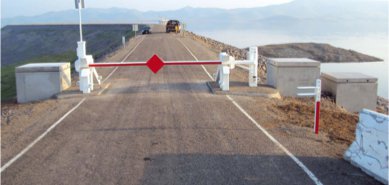
Delta Scientific, the leading manufacturer of counter-terrorist vehicle control systems used in the United States and internationally, announced that Delta vehicle access control systems are being implemented at dams, nuclear power plants, and other power generation sites, distribution centers and sub-stations because they meet the stringent standards recently set under the National Infrastructure Protection Plan for the energy sub-sector.
The plan was instituted by the North American Electronic Reliability Corporation with backing by the Federal Energy Regulatory Commission.
“Known as CIP-014, the Critical Infrastructure Protection Reliability Standard 014 is being studied, budgeted, and implemented by major utilities to bolster physical security improvement at the perimeter and their openings,” reports Greg Hamm, Delta Scientific vice-president, marketing and sales. “We are increasingly working with power utilities to provide vehicle attack defense from terrorists with our cable fencing, retractable barriers, barricades and bollards, fixed bollards, crash-proof gates and ultra-secure sally ports.”
Realizing that a vehicle can go through a chain link fence like a hot knife through soft butter, many utilities are securing their outer perimeters with Delta’s cable fencing, which consists of two three-quarter-inch diameter steel cables suspended from line posts spaced at 10-foot intervals.
Such cable systems stop a 4,000-pound vehicle traveling at 52 miles per hour.
Each pipe extends 44 inches above ground and is embedded 40 inches deep in a 10-inch diameter concrete footing. The cable ends are fastened to concrete deadmen casts in the ground every 100 feet. Cables are placed at 30 inches and 35 inches above the ground.
Such fences keep errant vehicles some distance from the facility itself.
The same retractable Delta barriers, barricades, and bollards that protect over 17,000 of the world’s most important facilities around the globe are also being used at generation and distribution entrances.
Kept in an upright position, they lower only to allow passage of authorized vehicles, acting as the first line of defense at critical locales. There are a wide variety of models, all crash certified, that can stop up to a 65,000 pound vehicle traveling at 50 miles per hour, approximately 5.4 million foot-pounds of energy.
One barricade, the DSC7500 swing beam, was created especially for the United States Department of the Interior’s Bureau of Reclamation to protect the nation’s water diversion, delivery, storage, and hydroelectric generation projects. The DSC7500 swing beam barricade closes off one or two lanes of a roadway and provides counter terrorist level protection against vehicle attack.
The DSC7500 is supplied as an easy to use manual gate or powered with full automation features. Sliding gates are also available in several forms, including tracked and cantilevered, that carry ratings up to ASTM M50.
With Delta DSC600 fixed bollard modules, energy companies can safely protect facilities surrounded by streets, abutting sidewalks and set back on lawns. With a foundation only 14 inches deep, the fixed bollards can be installed on sidewalks, atop concrete deck truss bridges, or in planters as well as conform to the inclines and turns of the locale.
Utilities also use Delta crash-proof gates to stop unauthorized pedestrians and vehicles from entering places that they don’t belong. Some models slide without contact with the ground across the opening. Others are swing version.
Clear openings range from 12-30 feet with a standard height of 109 inches. They can withstand impacts as high as a 15,000 pound vehicle striking at 50 miles per hour, suffering no significant damage.
“We look forward to helping electrical power organizations meet the parameters of CIP-014,” adds Hamm. “From some of America’s most famous dams to 85 percent of the nation’s nuclear power plants, we’re very experienced in dealing with power generation and distribution organizations.”
Source: deltascientific.com
